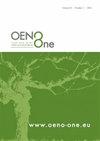Impact of cluster thinning and harvest date on berry volatile composition and sensory profile of <i>Vitis</i> sp. Seyval blanc and Vandal-Cliche
IF 2.2
3区 农林科学
Q3 FOOD SCIENCE & TECHNOLOGY
引用次数: 0
Abstract
Northern conditions are challenging for grape and wine producers. To cope with these challenges, the use of early ripening interspecific hybrid Vitis sp., such as Seyval blanc and Vandal-Cliche, is often preferred to traditional V. vinifera. However, knowledge about cultural practices suitable for interspecific hybrid varieties are still scarce, especially regarding their impact on profiles of volatile compounds and the sensory perception of berries. In this study, the impact of cluster thinning and harvest date on grapevine physiology, must chemical composition and berry sensory attributes of Seyval blanc and Vandal-Cliche was investigated. Three crop loads (100 %, 70 % and 40 % crop) and three harvest dates corresponding to pre-maturity, maturity, and post-maturity were assessed in 2012 and 2013. Cluster thinning significantly decreased the yield of Vandal-Cliche, but not of Seyval blanc, for which it instead improved fruit set without affecting yield. The impact of cluster thinning on must chemical composition was limited for both cultivars, although some significant changes were observed, especially in the cool season of 2013. Clear variations during ripening, in terms of technological parameters and aroma characteristics, were observed depending on the cultivars and the seasons. In Seyval blanc, C6-alcohols and C13-norisoprenoids decreased during ripening, while C6-aldehydes and linalool increased. In Vandal-Cliche, berries from the first and the last sampling dates of the warm season of 2012 showed the highest levels of C13-norisoprenoids, whereas berries from the last sampling date in the cold season of 2013 showed the highest levels of terpenes, C13-norisoprenoids and ethyl esters. Despite its limited impact on fruit chemical composition, cluster thinning significantly impacted the sensory perception of Vandal-Cliche berries in both years. Cluster-thinned berries had softer skin, sweeter and less acidic pulp, and fruitier skin and pulp aroma. Skin softness allowed excellent discrimination of the maturity of both cultivars during the two study years, suggesting that this descriptor could be a suitable maturity marker for these interspecific hybrid varieties. In summary, cluster thinning proves beneficial for enhancing fruit set in Seyval Blanc in a northern climate; however, its influence on fruit quality is minimal for both cultivars.间伐和采收期对葡萄果实挥发性成分和感官特征的影响塞瓦尔勃朗和汪达尔陈词滥调
北方的气候条件对葡萄和葡萄酒生产商来说是一个挑战。为了应对这些挑战,使用早熟的种间杂交葡萄,如塞瓦尔白葡萄和汪达尔-卡什兰葡萄,通常比传统的葡萄更受欢迎。然而,关于适合种间杂交品种的栽培方法的知识仍然很少,特别是关于它们对挥发性化合物特征和浆果感官知觉的影响。本研究研究了间伐和采收期对塞瓦尔白葡萄和汪达尔-陈腐葡萄的生理、化学成分和浆果感官属性的影响。2012年和2013年评估了3种作物负荷(100%、70%和40%)和3个收获日期,分别对应于早熟、成熟期和后成熟期。间伐可显著降低汪达尔-陈cliche的产量,但对白塞瓦尔没有影响,反而提高了坐果,但不影响产量。间伐对两个品种的挥发油化学成分的影响有限,但在2013年凉爽季节发生了显著变化。在成熟过程中,根据不同的品种和季节,在工艺参数和香气特征方面存在明显的差异。白塞弗尔在成熟过程中,c6 -醇类和c13 -异戊二烯类含量下降,而c6 -醛类和芳樟醇含量上升。在Vandal-Cliche, 2012年温暖季节的第一个和最后一个采样日期的浆果显示出最高水平的c13 -去甲异戊二烯类,而2013年寒冷季节的最后一个采样日期的浆果显示出最高水平的萜烯、c13 -去甲异戊二烯类和乙酯。尽管簇减薄对果实化学成分的影响有限,但在两年中都显著影响了汪达尔-陈词滥调浆果的感官知觉。果皮更柔软,果肉更甜,酸性更少,果皮和果肉香气更浓郁。在两个研究年份中,皮肤柔软度可以很好地区分两个品种的成熟度,这表明该描述符可以作为这些种间杂交品种的成熟标记。综上所述,在北方气候条件下,间伐证明有利于提高塞瓦尔白葡萄的坐果率;然而,它对果实品质的影响对两个品种都是最小的。
本文章由计算机程序翻译,如有差异,请以英文原文为准。
求助全文
约1分钟内获得全文
求助全文
来源期刊

OENO One
Agricultural and Biological Sciences-Food Science
CiteScore
4.40
自引率
13.80%
发文量
85
审稿时长
13 weeks
期刊介绍:
OENO One is a peer-reviewed journal that publishes original research, reviews, mini-reviews, short communications, perspectives and spotlights in the areas of viticulture, grapevine physiology, genomics and genetics, oenology, winemaking technology and processes, wine chemistry and quality, analytical chemistry, microbiology, sensory and consumer sciences, safety and health. OENO One belongs to the International Viticulture and Enology Society - IVES, an academic association dedicated to viticulture and enology.
 求助内容:
求助内容: 应助结果提醒方式:
应助结果提醒方式:


